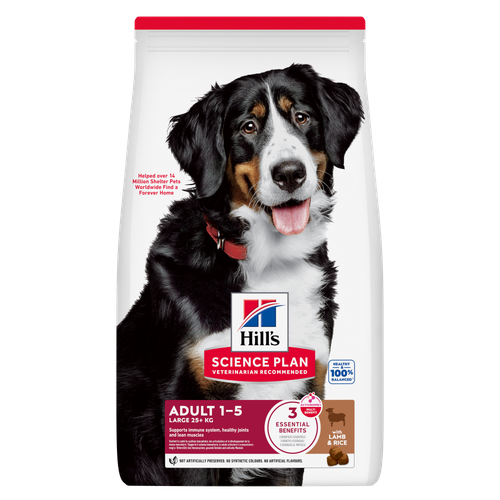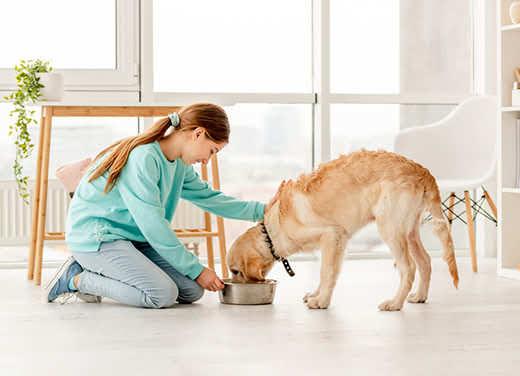
-
Find the right food for your petTake this quiz to see which food may be the best for your furry friend.Find the right food for your petTake this quiz to see which food may be the best for your furry friend.Featured products
 Perfect Digestion Large Breed Puppy Food
Perfect Digestion Large Breed Puppy FoodPrecisely balanced nutrition with Hill's ActivBiome+ prebiotic blend actively contributes to supporting digestive health and overall well-being to help your pet feel their best
Shop Now Perfect Digestion Small & Mini Adult Dog Food
Perfect Digestion Small & Mini Adult Dog FoodHill's Science Plan Perfect Digestion Small & Mini Breed Adult Dog Food with Chicken & Brown Rice supports ultimate digestive well-being & a healthy microbiome.
Shop Now Small & Mini Mature Adult 7+ Dog Food
Small & Mini Mature Adult 7+ Dog FoodHill's Science Plan Small & Mini Breed Mature Adult Dog Food with Chicken is a complete pet food, specially formulated with ActivBiome+ Multi-Benefit Technology.
Tailored nutrition to support graceful ageing in small dogs. Specially made with a synergistic blend of nutrients for energy & vigor.Shop NowFeatured products Hypoallergenic Dry Cat Food
Hypoallergenic Dry Cat FoodHILL'S SCIENCE PLAN Hypoallergenic Adult cat food with egg & insect protein is a complete pet food for adult cat 1–6 years old. It's formulated for cats with delicate skin and stomach, with limited high quality novel protein sources & no grain.
Shop Now Kitten Food
Kitten FoodTender chicken chunks in gravy for kittens, with omega-3s for healthy eye & brain development and high-quality protein to support muscle growth. With balanced minerals to promote strong bones & teeth.
Shop Now Hairball & Perfect Coat Adult Cat Food
Hairball & Perfect Coat Adult Cat FoodHill's Science Plan HAIRBALL & PERFECT COAT Adult cat food with Chicken is specially formulated to effectively help avoid hairball formation in adult cats while promoting a beautiful coat. Thanks to its mix of essential Omega-6 fatty acids, this food benefits the cat's skin and fur keeping them healthy and shiny. Our Advanced Fibre Technology helps reduce hairballs by naturally promoting their passage through the gut. This food is formulated with high-quality protein for a perfectly balanced, great-tasting recipe.
Shop Now -
Dog
- Dog Tips & Articles
-
Health Category
- Weight
- Food & Environmental Sensitivities
- Urinary
- Digestive
- Joint
- Kidney
-
Life Stage
- Puppy Nutrition
- Adult Nutrition
- Senior Nutrition
Cat- Cat Tips & Articles
-
Health Category
- Weight
- Skin & Food Sensitivities
- Urinary
- Digestive
- Kidney
-
Life Stage
- Kitten Nutrition
- Adult Nutrition
Featured articles The Right Diet For Your Pet
The Right Diet For Your PetLearn what to look for in healthy pet food & nutrition, including ingredients, quality of the manufacturer, your pet's age, and any special needs they have
Read More Understanding Your Pet's Microbiome
Understanding Your Pet's MicrobiomeLearn what a pet's microbiome is, how it contributes to your pet's gut & overall health, and why nutrition is important in maintaining healthy microbiomes.
Read More Pet Food Storage Tips
Pet Food Storage TipsWhere you store your cat and dog food can make a big difference in the quality and freshness once it is opened. Here are some common questions and recommendations for optimal storage for all of Hill’s dry and canned cat and dog food.
Read More -


Adding a new companion to the household creates warm, fuzzy feelings of excitement and compassion. But you may wonder, especially if you're a potential first-time dog owner, "Do I have time for a dog? And how much attention does a dog need each day?" Let's run through how to make your new dog feel welcome and how you'd integrate a dog into your schedule. Let's dig a little deeper into understanding how much time you need for a dog.
 How Can I Make My Dog Feel Welcome?
How Can I Make My Dog Feel Welcome?
As a pet parent, it's important to remember that your first few weeks with your new pet will look different until you've established a routine. When bringing a pet home, you're entering into a transitional period as you learn about each other.
During the first week of being a pet parent, you'll focus on gathering all the supplies needed, making space in your home for a kennel or dog bed, showing your pet around the home, exploring the yard on a leash, meeting human family members, possibly switching to new dog food, working on training skills, bonding with your pet and meeting a veterinarian for an initial exam and checkup.
After experiencing all these firsts together, you'll fall into the rhythm of daily life that works for everyone in the household, including your new dog. With that said, there are occasional commitments to think about, such as follow-up veterinary visits, time to shop for pet supplies and scheduling appointments with the groomer.


Tasty Tips
How Much Time Do You Need for a Dog?
At the start, you may want to spend all your waking hours playing fetch and cuddling your new pet, but then reality sets in — you have to tend to your other commitments, too. Here's a peek at how much time your pet may require once settled into a routine:
- 6:00-6:15 a.m.: Let the dog outside to potty. Or, you may need to take your pet on a short walk if you live in an apartment without a designated yard space for your pet.
- 7:00-7:15 a.m.: Feed your pet breakfast. Provide fresh water and kibble so that your pet is fueled for the first half of the day. Remember to wash the bowls each day to reduce bacteria growth.
- 12:00-12:30 p.m.: Midday check-in. If you work from home or have a pet sitter on speed dial, have them give your fur baby a potty break around noon. Some pets also like a small lunch, so offer that if your dog is interested. Always have fresh water available.
- 5:30-5:45 p.m.: Let your pet outside to potty. This might be a quick visit to the yard or a walk around the block. During this time, casually socialising with your pet by working on a few obedience commands or tossing a ball for them to fetch. If they've been alone for a few hours, they'd love the attention!
- 6:00 p.m.: Feed your pet as you prepare dinner for yourself.
- 7:30-8:30 p.m.: Spend quality time with your pet. This might be a long walk on a park trail or maneuvering an agility course set up in the garage. This one-on-one time is important for mental nurturing and bonding with your pet. It's a good idea to also use this time for basic at-home grooming, like brushing your dog's fur and teeth.
- 9:45-10:00 p.m.: Give your pet a bedtime potty break. If you've been active earlier in the evening your pet may not need to go, but it's nice to offer before the two of you curl up for the evening. This step is especially important for puppies who are potty training and can't hold their urine as long as an adult dog.
This schedule reflects a typical Monday through Friday workweek. On the weekend or other days off, you'll likely shift your schedule a bit. Consider adding time for a doggie play date at the dog park, training classes or outdoor adventures. The weekends are also a good time to make your home more pet friendly. Maybe you need to install fencing, shop for an additional dog bed or clean up waste in the yard.
 Do I Have Time for a Dog?
Do I Have Time for a Dog?
A dog shouldn't be alone for more than six to eight hours each day, according to the American Kennel Club. If they are, your pet may begin to experience separation anxiety, a symptom of feeling stressed from isolation. Your pet may chew or scratch personal property or the walls and doors in an effort to get out of the home and find you.
You can always lean into a pet sitter, dog walker, doggie daycare, neighbour or other family members to assist with pet care throughout the day. However, these folks should supplement your pet care schedule, not become the primary caretakers of your new dog. You are the pet parent, first and foremost.
Rest assured, your pet loves to drift off to dreamland when you're busy with other tasks. According to the National Sleep Foundation, the average dog sleeps 12 to 14 hours daily. Puppies, older dogs and large breeds like Newfoundlands and mastiffs snooze through even more hours each day.
Making the decision to adopt a dog requires careful consideration of your current time and financial commitments. Ask yourself: Do I have gaps in the evening that I'd like to fill with a canine companion? Can I make time at the start of my day for potty time and feeding the dog? Do I have extra funds to pay for food, vet care and pet supplies? Do I enjoy being active and going for walks each day? Overall, do I have time for a dog and their needs in addition to taking care of my daily responsibilities? These are all things to consider when adopting a pet and making them part of your daily life.


Angela Tague is a pet mom and writer living in the Midwest. When she's not making a mess in the kitchen, exploring nature trails with her dog, or attending a yoga workshop, she's writing full-time for multiple lifestyle and technology brands. You can find her on Twitter and LinkedIn @AngelaTague.
Related products

Hill's Science Plan Large Breed Adult Dog Food with Lamb & Rice is a complete pet food, specially formulated with ActivBiome+ Multi-Benefit Technology.
This food is specifically designed to fuel the energy needs of large breed dogs during the prime of their life.

Hill's Science Plan Small & Mini Breed Mature Adult Dog Food with Chicken is a complete pet food, specially formulated with ActivBiome+ Multi-Benefit Technology.
Tailored nutrition to support graceful ageing in small dogs. Specially made with a synergistic blend of nutrients for energy & vigor.

Hill's Science Plan Perfect Digestion Small & Mini Breed Adult Dog Food with Chicken & Brown Rice supports ultimate digestive well-being & a healthy microbiome.

Precisely balanced nutrition with Hill's ActivBiome+ prebiotic blend actively contributes to supporting digestive health and overall well-being to help your pet feel their best
Related articles

Dog obesity is a significant problem - learn more about helping your dog become trimmer and healthier through improved nutrition.

Discover how the field of dog science is giving us more and more insights into the inner workings of our furry best friends.

Learn about snake bites on dogs, including clinical symptoms to look for, what to do if you think your dog was bitten, and treatment & prevention options.

Discover the causes, signs, and treatments of kidney disease in dogs and find methods of supporting your dog's kidney health. Learn more at Hill's Pet South Africa.

Put your dog on a diet without them knowing
Our low calorie formula helps you control your dog's weight. It's packed with high-quality protein for building lean muscles, and made with purposeful ingredients for a flavorful, nutritious meal. Clinically proven antioxidants, Vitamin C+E, help promote a healthy immune system.
Put your dog on a diet without them knowing
Our low calorie formula helps you control your dog's weight. It's packed with high-quality protein for building lean muscles, and made with purposeful ingredients for a flavorful, nutritious meal. Clinically proven antioxidants, Vitamin C+E, help promote a healthy immune system.


